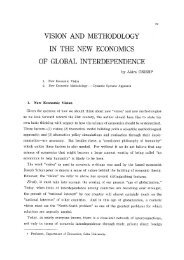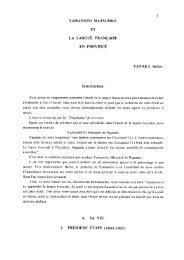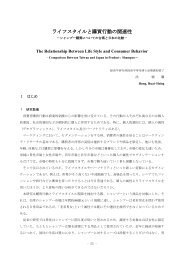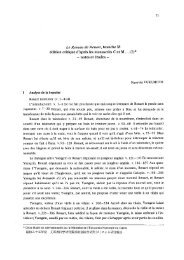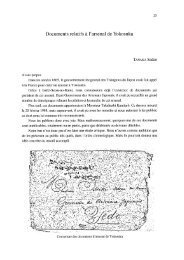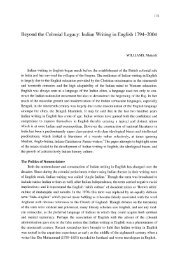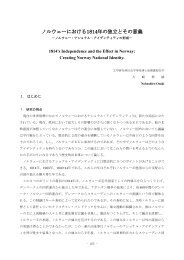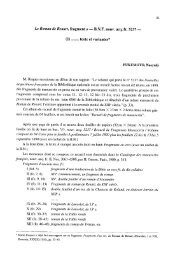New Historicism and Literary Studies - Soka University Repository
New Historicism and Literary Studies - Soka University Repository
New Historicism and Literary Studies - Soka University Repository
Create successful ePaper yourself
Turn your PDF publications into a flip-book with our unique Google optimized e-Paper software.
124<br />
altered the very perspectives that created our world. The constructionist approach was a radical<br />
departure from the earlier reflective <strong>and</strong> intentional approaches. The reflective approach saw<br />
inherent meaning (in objects, events, ideas, people) in the world which language reflected. The<br />
Greeks notion of mimesis employed a reflective approach to show how language <strong>and</strong> drawing<br />
reflected nature. This led them to a mimetic theory through which they saw Homer's Iliad<br />
imitating heroic events in the universe. The intentional approach on the contrary argued that the<br />
author/speaker imposes his/her meaning on the universe through the medium of language. But<br />
language has its own conventions, codes <strong>and</strong> rules that we must negotiate in order to express<br />
our thoughts clearly. Language possesses a distinctive social character, which is more or less<br />
free from any intrinsic meaning that things might possess or people might ascribe in the act of<br />
speaking or writing. There is no a priori meaning of things.<br />
The constructionist approach argued that we construct meaning through a system of<br />
symbolic representation by using concepts <strong>and</strong> signs. The material world exists in its own right<br />
but it only acquires meaning when we use a language system. Obviously, the meaning of<br />
objects does not remain the same from one culture to another as each culture has different<br />
cultural codes, classificatory system <strong>and</strong> signification. So by <strong>and</strong> large representation accepts<br />
some degree of cultural relativism or lack of one-to-one correspondence in meaning. We<br />
therefore require a method of translating mindset or conception of the universe of one culture<br />
<strong>and</strong> another, if we are to succeed in underst<strong>and</strong>ing meanings in other cultures partially.<br />
Discourses, representation <strong>and</strong> knowledge acquire the force of truth only within distinct<br />
historical context, <strong>and</strong> possess no logical continuity from one historical context to another. By<br />
historicizing discourse or episteme, Foucault worked against the ahistorical method in<br />
semiotics. In The Archeology of Knowledge, Foucault deconstructed the dominant discourse of<br />
madness in society. Madness, for instance, was not an objective fact but a function of a<br />
discursive formation that defined madness in a specific manner for a madman to appear.26<br />
Similarly sexuality <strong>and</strong> hysteria were also constructed within their own discourses . Sexual<br />
desire <strong>and</strong> fantasy appeared in Western societies at a particular historical moment <strong>and</strong> not<br />
before.27 Homosexual forms of behavior existed in the past but the homosexual as a specific<br />
social category was produced in the late 19th century based on the century's theories of sexual<br />
perversity. The hysterical woman also appeared with the emergence of the 19th century view of<br />
hysteria as primarily a female illness!'<br />
The rise of industrial society in 17th century Europe created a sense of intolerance towards<br />
madmen. Madmen, together with idlers, prostitutes, sick <strong>and</strong> unemployed were interned as<br />
capitalist society could not tolerate "groups of vagabonds." Foucault argues that the "incapacity<br />
to work is the first criterion of madness."29 In the 18th century the situation changed for other<br />
categories of vagabonds except madmen. As the speed of industrial development accelerated in<br />
the 19'h century, unemployed proletariats were seen as reserve labor force <strong>and</strong> were let out into<br />
society. But those who could not work were still considered mad <strong>and</strong> remained confined .<br />
Foucault concludes: "It could be said that the madman is an avatar of our capitalist societies,<br />
<strong>and</strong> it seems that, at bottom, the status of the madman does not vary at all between primitive<br />
societies <strong>and</strong> advanced societies. This only demonstrates the primitivism of our societies ."30<br />
In The Birth of the Clinic, Foucault explores the shift in medical underst<strong>and</strong>ing of the<br />
nature of disease. The classical notion explained the existence of disease as separate from the



